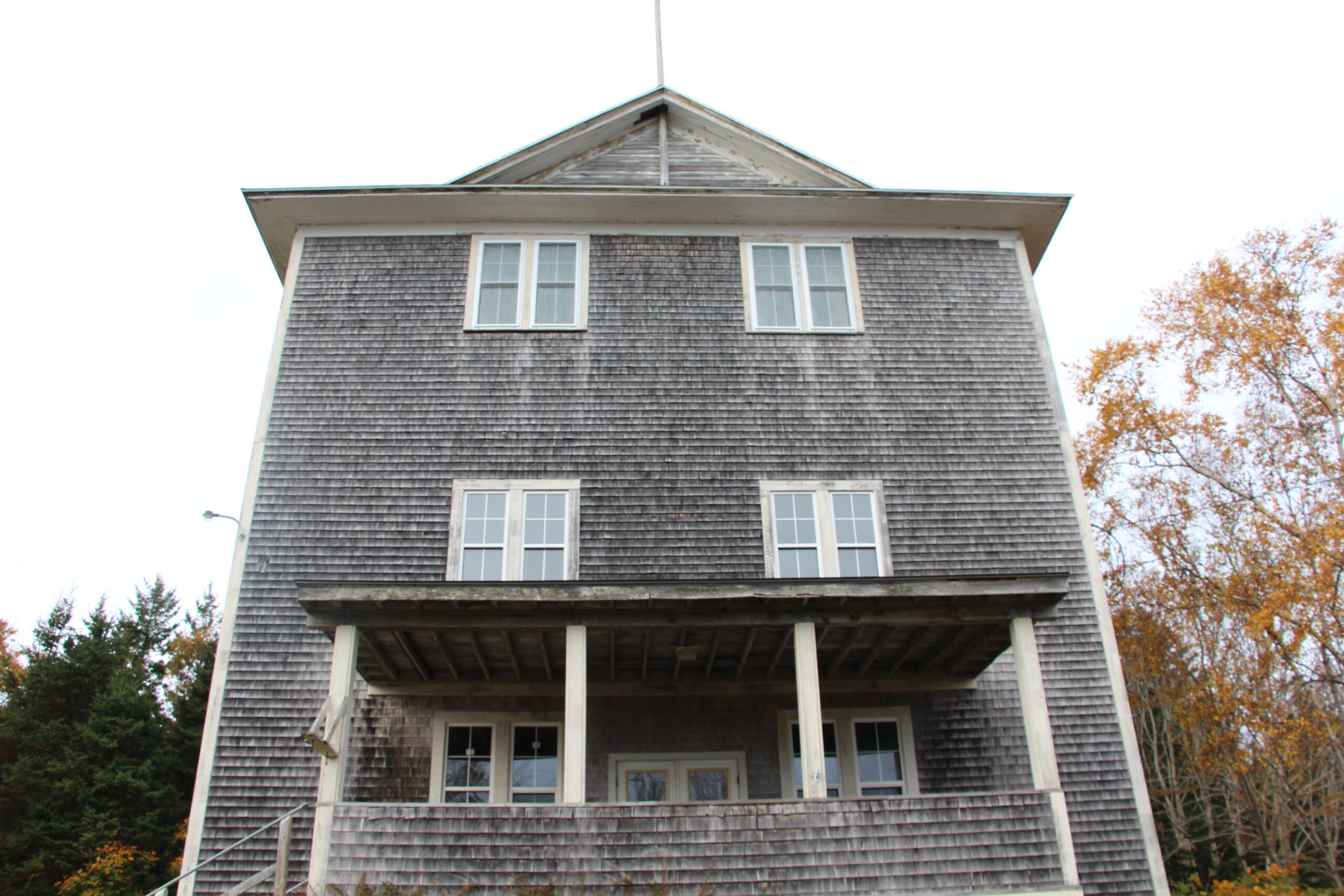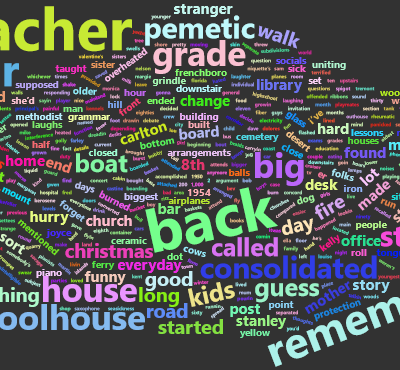Swan's Island, Maine
Swan's Stories of Commons and Change
This project is a collection of stories, word clouds, and images from Swan’s Island’s evolving community locations. After reading over fifty interviews and conducting several of our own, we focused on five locations that seemed most important to the community: the waterfront, outdoor spaces, the Odd Fellow’s Hall, the island’s school, and the state ferry terminal. For each, we composed an exhibit including audio story collections and data visualizations. This project was created by College of The Atlantic students for the course ‘Navigating Change: People, Places, Stories’.

Navigating Change

Word clouds were one of the ways location data was visualized.
Navigating Change: People, Places, Stories is a course about how coastal communities in Frenchman Bay are responding and adapting to changes of all kinds. In the first five weeks of the course, we traveled around Frenchman Bay and spoke with members of different communities on what changes they were experiencing . After our class trip to Swan’s Island, our group of five students focused on the island for our final project.
We came up with a few different themes, but decided that we hadn’t been on the island long enough to draw a conclusion. For this reason, we began contextual and background research about Swan’s Island, learning about the history of the place and people. We then moved to reading the archival transcripts from interviews that were done between 2009-2012 for the Swan’s Island Memory Project. After reading a handful of these transcripts and traveling to the island multiple times, it became clear to us the importance of communal spaces for this island community. We stayed with Olivia Jolley, a COA alum and current Island Fellow working at the Historical Society on Swan’s Island. We decided to move forward reading all 54 archived transcripts, pulling quotes mentioning places. We created a list of various places such as the school(s), churches, ferry, fisherman’s co-op, wharfs, etc. and collected the stories told about them. At the same time, a spreadsheet was created to document how often and in what context places were mentioned. Between these two strategies we were able to highlight the most frequently mentioned locations. These were the Odd Fellows Hall, School(s), Ferry, Outdoor Spaces, and the Waterfront.
Listen to these stories and be transported to Swan’s Island.
From work to play, land to sea, these audio pieces document gathering places on Swan’s Island and how they have changed over time. Listen to dances at the Odd Fellows Hall, ferry rides, and swimming at the quarry pond. Each story describes an aspect of community life. The audio pieces are made up of stories told by a variety of different Swan’s Islanders. These stories have combined together to highlight the importance and function of each community space.
To access transcripts of the audio pieces, click here.

Waterfront
Human activity on Swan’s Island begins and ends with the ocean. These days the water supports the island’s primary industry, even as working waterfront is eroded by residential projects. Locations like Kent’s Wharf and the Lobster Co-op ensure fishermen have the infrastructure necessary to stay in business. Life on the island remains indivisibly tied to the water.

“Course back then years and years and years ago, they went
lobstering, but before that there was a mackerel fishery. They didn’t really care too much for lobsters. They were all mackerel fishermen. That’s a long time ago, that’s back before I was born. Then lobstering took over I guess. Everybody always thought that we were gonna’ catch the last one but we never have.”
– Spencer Joyce

Speakers: Betsy Philbrook, Kim Colbeth, Sonny Sprague, Donely Donna, Normie Burns, George Tainter.

Speakers: Bernita Joyce, Robert Nitsche, Nancy Carter, Marion Stinson, Donely Donna, Bonnie Holmes.
Outside Spaces
The outdoors boast some of the most popular gathering spaces on the island. Most frequently this involves recreational activities such as baseball games, swimming, and ice skating. In many stories the ball field is at the center of it all, serving as a home base when Swan’s team went to state. Outdoor spaces used to be a staple of a Swan’s Island childhood.

“I never remember a summer where she didn’t pack us up and go to the Quarry Pond on any day that might be acceptable to swim”.
– Clint Staples
Odd Fellows Hall
Swan’s Odd Fellows Hall was constructed over one hundred years ago in 1909 and since then has been the site of community celebrations, dances, and gatherings. The island’s Odd Fellows facilitated dances and community meetings, such as discussions leading up to the creation of the Lobster Co-op. Nowadays the hall hosts town meetings and community breakfasts.

“The dances was the Odd Fellows Hall. And sometimes we’d play two or three dances a weeks and get five dollars a night. But it was fun. I have seen it when it there was two lines of Contra Dances, two lines. And the place would be crowded”.
– Marion Stinson

Speakers: Ralph Hagopian, George Tainter, Marion Stinson, Bonnie Holmes, James Ranquist, Eva Wheaton, Clint Staples, Theo May.

Speakers: Kim Colbeth, Bernita Joyce, Clint Staples, Nancy Carter.
School
School is an imperative part of any island’s year-round existence, and Swan’s is no different. Supported by the majority of the town’s tax revenue, the Swan’s Island School is only the latest iteration of the island’s education system. Previously three separate schools for Minturn, Atlantic, and the Village, consolidation was complete by [1951]. Back then, island kids would finish eight grades of school on-island before heading off to MDI or the mainland.

“While I was teaching the school district, because we’re part of the MDI district, they decided that all fourth graders should learn about MDI history. Well, Swan’s Islanders are sometimes renegades and I thought that was really stupid thing for us to learn because we don’t live in MDI and Swan’s Island was pretty interesting. So I developed Swan’s Island studies instead.”
– Kim Colbeth
The Ferry
The arrival of a state-run ferry on Swan’s Island had serious impacts on the community’s access to goods and off-island services. Before the ferry arrived in 1960 islanders and summer people alike had to find their own means of transportation for high-school students, groceries, and heavy machinery. While the ferry hasn’t lifted every travel difficulty, it’s service has still provided access to Swan’s Island.

“We are one of the bigger islands, and the ferry makes a big difference between us and the Cranberries or Frenchboro or Matinicus.”
– Kim Colbeth

Speakers: Marguerite Staples, Sonny Sprague, Nancy Carter, Kim Colbeth, Theo May.
Explore these word clouds
After parsing through past and present interviews of Swan’s Island residents and collecting quotes related to community spaces, we have created word clouds corresponding to each place we focused on in our audio stories. Each word cloud is made up of quotes either from past interviews or the interviews we have conducted in order to show how relevant aspects of these spaces have changed. The size of each word corresponds to the number of times it was mentioned in regards to a specific place across all interviews.

Thank you.
Thank you so much to all those we interviewed: Nancy Carter, Beverly McAloon, Laurel LeMoine, and Kim Colbeth. A special thanks to Oliva Jolley of the Swan’s Island Historical Society, this project could not have been done without you.
This project is made possible by The Swan’s Island Historical Society and College of The Atlantic.
This project was created by Morgan Urban, Natalie Rodriguez Dickens, Phoebe Wagner, Sophia Rexing, and Tiegan Paulson of College of The Atlantic.









